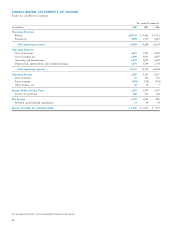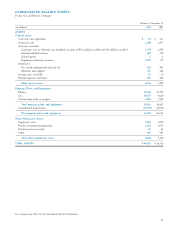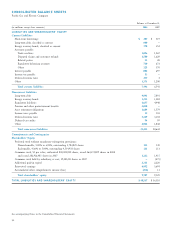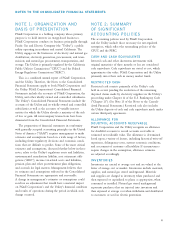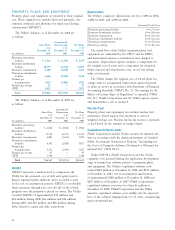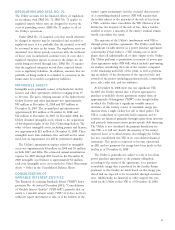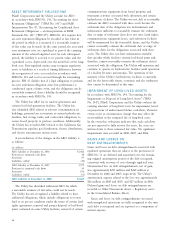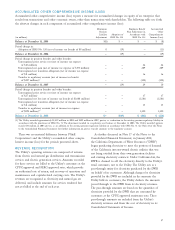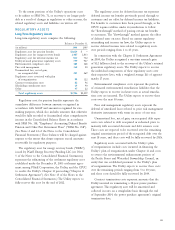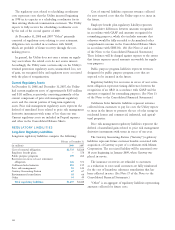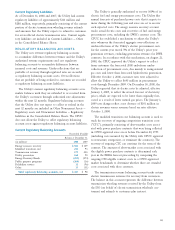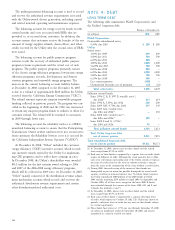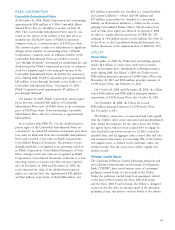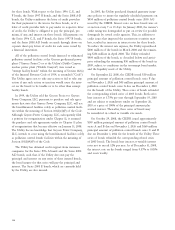PG&E 2008 Annual Report Download - page 100
Download and view the complete annual report
Please find page 100 of the 2008 PG&E annual report below. You can navigate through the pages in the report by either clicking on the pages listed below, or by using the keyword search tool below to find specific information within the annual report.98
earnings, or to the extent they are recoverable through
regulated rates, are deferred and recorded in regulatory
accounts. Derivative instruments may be designated as cash
fl ow hedges when they are entered into to hedge variable price
risk associated with the purchase of commodities. For cash
fl ow hedges, fair value changes are deferred in accumulated
other comprehensive income and recognized in earnings as
the hedged transactions occur, unless they are recovered in
rates, in which case, they are recorded in regulatory accounts.
In order for a derivative instrument to be designated as
a cash fl ow hedge, the relationship between the derivative
instrument and the hedged item or transaction must
be highly effective in hedging the exposure to variability
in expected future cash fl ows. The effectiveness test is per-
formed at the inception of the hedge and each reporting
period thereafter, throughout the period that the hedge
is designated as such. Unrealized gains and losses related
to the effective and ineffective portions of the change in the
fair value of the derivative instrument, to the extent they
are recoverable through rates, are deferred and recorded in
regulatory accounts.
Cash fl ow hedge accounting is discontinued prospectively
if it is determined that the derivative instrument no longer
qualifi es as an effective hedge, or when the forecasted
transaction is no longer probable of occurring. If cash fl ow
hedge accounting is discontinued, the derivative instrument
continues to be refl ected at fair value, with any subsequent
changes in fair value recognized immediately in earnings.
Gains and losses previously recorded in accumulated other
comprehensive income (loss) will remain there until the
hedged item is recognized in earnings when it matures
or is exercised, unless the forecasted transaction is probable
of not occurring, in which case the gains and losses from the
derivative instrument will be immediately recognized in earn-
ings. Any gains and losses that would have been recognized
in earnings or deferred in accumulated other comprehensive
income (loss), to the extent they are recoverable through
rates, are deferred and recorded in regulatory accounts.
The fair value of derivative instruments is estimated
using various methods including the use of unadjusted
prices in active markets to determine the net present value
of estimated future cash fl ows, the mid-point of quoted
bid and asked forward prices, including quotes from brokers,
and electronic exchanges, supplemented by online price infor-
mation from news services, and the Black’s Option Pricing
Model. When market data is not available, proprietary
models are used to estimate fair value.
INCOME TAXES
PG&E Corporation and the Utility use the liability
method of accounting for income taxes in accordance
with SFAS No. 109, “Accounting for Income Taxes” (“SFAS
No. 109”). Income tax expense (benefi t) includes current
and deferred income taxes resulting from operations during
the year. Invest ment tax credits are amortized over the life
of the related property. See Note 10 of the Notes to the
Consolidated Financial Statements for further discussion
of income taxes.
PG&E Corporation fi les a consolidated U.S. federal
income tax return that includes domestic subsidiaries in
which its ownership is 80% or more. In addition, PG&E
Corporation fi les a combined state income tax return in
California. PG&E Corporation and the Utility are parties to
a tax-sharing agreement under which the Utility determines
its income tax provision (benefi t) on a stand-alone basis.
NUCLEAR DECOMMISSIONING TRUSTS
The Utility accounts for its investments held in the Nuclear
Decommissioning Trusts in accordance with SFAS No. 115,
“Accounting for Certain Investments in Debt and Equity
Securities” (“SFAS No. 115”), as well as FASB Staff Position
Nos. 115-1 and 124-1, “The Meaning of Other-Than-Temporary
Impairment and Its Application to Certain Investments”
(“SFAS Nos. 115-1 and 124-1”). Under SFAS No. 115, the
Utility records realized gains and losses as additions and
reductions to trust asset balances. In accordance with SFAS
Nos. 115-1 and 124-1, the Utility recognizes an impairment
of an investment if the fair value of that investment is
less than its cost and if the impairment is concluded to
be other-than-temporary. (See Note 13 of the Notes to the
Consolidated Financial Statements for further discussion.)
ACCOUNTING FOR DERIVATIVES
AND HEDGING ACTIVITIES
The Utility engages in price risk management activities to
manage its exposure to fl
uctuations in commodity prices.
Price risk management activities involve entering into
contracts to procure electricity, natural gas, nuclear fuel,
and fi rm transmission rights for electricity.
The Utility uses a variety of energy and fi nancial instru-
ments, such as forward contracts, futures, swaps, options,
and other instruments and agreements, most of which are
accounted for as derivative instruments. Some contracts are
accounted for as leases. Derivative instruments are recorded
in PG&E Corporation’s and the Utility’s Consolidated
Balance Sheets at fair value, unless they qualify for the
normal purchase and sales exception. The normal purchase
and sales exception requires, among other things, physical
delivery of quantities expected to be used or sold over a
reasonable period in the normal course of business. Changes
in the fair value of derivative instruments are recorded in


